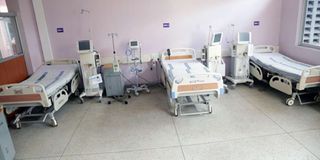Concessioning the best option

A hospital ward equipped with ICU equipment.
What you need to know:
- The whitest lie in the whole thing was the attempt at making us believe that the transaction with the equipment suppliers was a leasing arrangement.
- Most leasing contracts provide for the means and mechanisms for monitoring and tracking of use of the equipment.
- This scandal should not dissuade the government from adopting leasing as a model.
I read through the report and findings of Senate Committee on Health on the Sh50 billion medical equipment scandal and here is what I find revealing in it: We were dealing with greedy merchants whose only interest was to dump expensive equipment on county governments and it did not matter to them whether or not the taxpayer got value for money from the equipment.
But the whitest lie in the whole thing was the attempt at making us believe that the transaction with the equipment suppliers was a leasing arrangement. We all know that what you pay for in a lease is use of the equipment. Instead of outright purchase of the equipment, you enter into an arrangement where you pay for use during a specified time. Even installation, maintenance and replacement of parts is supposed to the responsibility of lessor.
Most leasing contracts provide for the means and mechanisms for monitoring and tracking of use of the equipment. The lessor must be able to monitor its use. If it is a motor vehicle, the lessor is the one to decide when it is released to him for scheduled service and maintenance.
During a visit to the Netherlands, the Senate committee discovered that a machine that was supposed to be supplied to a hospital in Meru was still in a store four years after the leasing programme had been commenced.
In Hola, it found that theatre and radiology equipment dumped there could not be put to use because the hospitals neither had reliable electricity nor trained staff. In Chuka, installation of equipment was still going on, four years later.
So why have we been paying billions of shillings to these contractors every financial year when some of the equipment had not even arrived in the country?
Clearly, these contracts were negotiated to allow payments to go on regardless of whether or not the expensive equipment was being used by the taxpayer. The contract provided for binding lease terms requiring automatic quarterly payments to the owners of the equipment. And the payments were made straight out of the Consolidated Fund, without first being moved to the County Revenue Fund as stipulated by both the Constitution and the Public Finance Management Act, thus making it difficult to follow the money trail.
The counties were left grossly exposed, forced to accept equipment under terms negotiated without their involvement and paid for without reference to them.
Supporter of leasing
In Laikipia, the committee found that X-ray and theatre equipment procured and supplied to hospitals by the national government before the devolved unit kicked in had to be removed to create space for that from the lease programme.
This scandal should not dissuade the government from adopting leasing as a model. I remain a supporter of leasing as an option, especially when you are purchasing assets that depreciate quickly.
Negotiated transparently and competently, leasing allows you to reduce the cost of acquiring assets that depreciate. Leasing allows you to spread the cost of acquiring expensive equipment over its useful economic life. The government has no business owning expensive gadgets that it is incapable of maintaining.
Negotiated well, leasing allows you to catch up with technology because the manufacturer is obliged to upgrade the equipment in line with emerging technologies.
As I read the report, I remembered similar scandals — like the mobile clinics one of last year. The project to purchase those contraptions was poorly conceived. That project had little or no economic justification beyond creating rent-seeking opportunities for public officials and the suppliers of the equipment.
Is it not the height of impunity that Afya House paid a whopping Sh800 million to purchase and import 100 of these portable clinics before doing something as rudimentary as hiring the staff to man the facilities? There were no plans on when and how the equipment was to be installed.
The agreement between the ministry and the vendors of the equipment — Messrs Estama Investments Ltd — did not provide details such as deadlines for delivery, quality and quantity inspections and payment conditions.
Why is it that we always get things wrong when it comes to purchasing equipment? Are we cursed? But then, wily merchants and their allies within the government have been dumping expensive equipment on the taxpayer.
I recently read somewhere how Nigeria has improved delivery of public health services by concessioning hospital to equipment manufacturers.
We ended up in the big mess of the medical equipment leasing transaction because somebody decided to drop the original idea of adopting concessioning as public hospitals have done in Nigeria.
That is where the rain started beating us.





